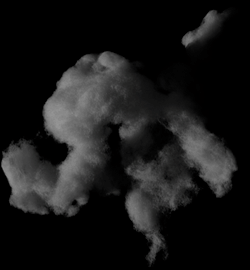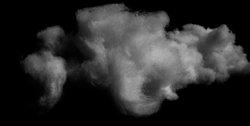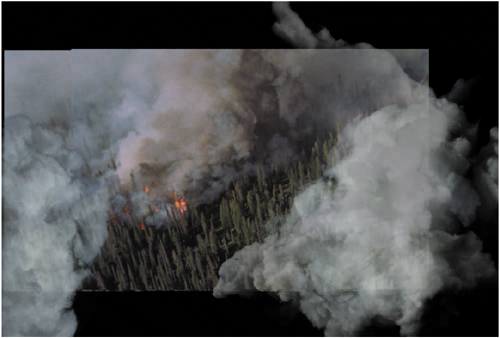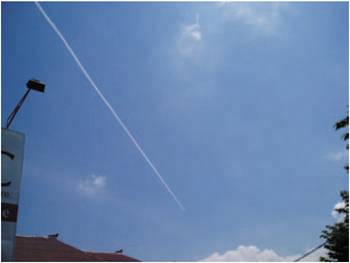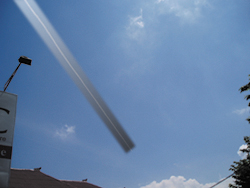Billowing Smoke
| Fractal Noise works fine for creating and animating thin wispy smoke and mist. It will not, however, help you re-create thick, billowing clouds. When clouds are opaque enough to have their own shape, shading, and topography, re-creating them with built-in After Effects plug-ins no longer does the job. Luckily, all you need is a good still cloud element and you can animate it in After Effects. And all you need to create the element is a high-resolution reference photoor a bag of cotton puffs. That's right, cotton puffs, like you get at the pharmacy. I first heard about this trick on a visit to the digital matte department at Industrial Light + Magic about a decade ago (back when the department was made up of four artists), where visionary matte painter Yusei Uesegi was given credit for devising it. He showed me a jaw-dropping shot of a pirate ship in flames, smoke billowing from the masts. The simplest way to create your basic cloud is to arrange the cotton balls on a large piece of nonreflective black poster board. Take the board outside on a sunny day so you get some nice highlights and shadows. When you photo-graph it at different angles to the light, the results look like puffy white clouds already (Figure 13.12). Figure 13.12. You may have noticed how cotton puffs can be arranged to resemble fluffy clouds. But who knew you could get away with sticking them in a movie?
To give your clouds some shape and contour, open the image in Photoshop, and use the Clone Stamp tool to create a cloud with the shape you want. You can do it directly in After Effects, but this is the kind of job for which Photoshop was designed. Clone in contour layers of highlights (using Linear Dodge, Screen, or Lighten blending modes) and shadows (with blending set to Multiply or Darken) until the cloud has the look you're after (Figure 13.13). Figure 13.13. The elements from Figure 13.12 have been incorporated into this Photoshop matte painting, with the shot into which the smoke will be composited in the background for reference (the extended shot moves left to right). The cotton has been painted in via a dozen overlapping layers. The topmost use Screen mode (to highlight) or Overlay mode (to darken), bringing out the contours. Can you tell which smoke is made up of cotton?
So now you have a good-looking cloud, but it's a still. How do you put it in motion? This is where After Effects' excellent distortion tools come into play, in particular Mesh Warp and Liquify.
Mesh WarpMesh Warp lays a grid of Bézier handles over the frame; you animate distortion by setting a keyframe for the Distortion Mesh property at frame 0, and then moving the points of the grid, and realigning the Bézier handles associated with each point to bend to the vertices between points. The image to which this effect is applied follows the shape of the grid. By default, Mesh Warp begins with a seven-by-seven grid. Before you do anything else, make sure that the size of the grid makes sense for your image; you might want to increase its size for a high-resolution project, and you can reduce the number of rows to fit the aspect ratio of your shot, so you begin with a grid of squares (Figure 13.14). Figure 13.14. The Mesh Warp controls are really quite simple: a grid of points and vectors. You can set the number and quality, and animate the position of the grid overall (one keyframe for all grid points). Points can be multiselected and dragged (as shown) and each point contains Bezier handles for warping the adjacent vectors. It's pretty cool, especially now that machines are fast enough to render the results effectively.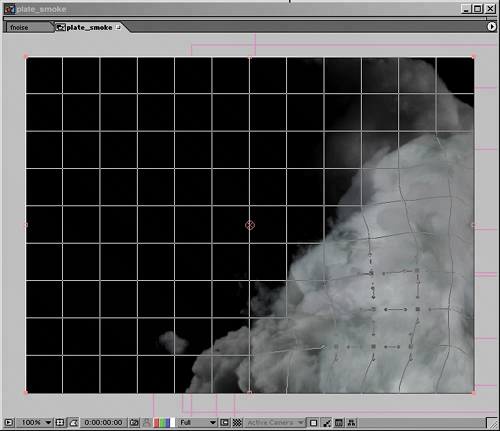 You can't typically get away with dragging a point more than about halfway toward any other point; watch carefully for artifacts of stretching and tearing as you work, and preview often. If you see stretching, realign adjacent points and handles to compensate.
LiquifyThe Liquify effect is a brush-based system for distorting footage; as such, it is useful in cases when a Mesh Warp grid is too cumbersome and finer adjustments are needed. Of the tools included with Liquify, the first two along the top row, Warp and Turbulence, are most likely to be useful (Figure 13.15). Warp has a similar effect to moving a point in Mesh Warp; it simply pushes pixels in the direction you drag the brush. Turbulence scrambles pixels in the path of the brush. The Reconstruction brush is like a selective undo, reversing distortions when you use the default setting; other options for this brush are contained in the Reconstruction Mode menu. Figure 13.15. Liquify is also a mesh distortion tool, only the mesh is much finer than Mesh Warp's and it is not visible by default. You can choose to display it under View Options in the effect controls. Here the Warp tool is being used to create an effect much like that created by the Mesh Warp in the previous figure, but via a brush rather than a grid.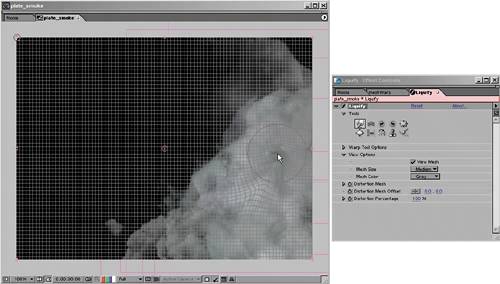 Liquify also has the advantage of letting you mask out areas that you don't want it to affect. Draw a mask around the area you want to leave untouched by Liquify brushes, but set the mask mode to None, disabling it. Under Warp Tool Options, select the mask name in the Freeze Area Masked menu. Lest you think the methods described in this section are some crude kludge, inferior to procedural particle dynamic effects created by a technical director in a sophisticated 3D rendering program, here's an anecdote that demonstrates how this generalized approach (refined to a high degree) saved the day on a movie with an eight-figure budget. A few short weeks before the final deadline for all shots to be completed on The Day After Tomorrow, the render pipeline at The Orphanage was slammed, but the "super cell" element for the freezing of New York City sequence (that huge cloud bank swirling around on the horizon) had not been approved by the client other than in matte paintings. It was clear that even if a technical director could re-create the look in 3Dand no one had done so yetthere wasn't going to be time left to render it. By animating the matte paintings using the techniques outlined in this section, the shots were completed and approved within a couple of weeks. As always, the key was breaking the problem down into component parts. The final super cell rig had over a dozen individual component layers and instances of Mesh Warp and Liquify, along with holdouts, overlays, offsets, and blending modes built up among them to give the effect the appropriate organic complexity and dimension. Combining TechniquesBecause each project varies, the techniques offered are meant to form only the basis of your finished effect. The goal is to provide you with a few keys that you can combine or part out on your own, rather than nail you down to specific steps that work only in one context. So, for example, selling a shot of the smoke plume might involve not only warping effects, but also some thinner, faster-moving smoke nearest the flames or in the foreground of the scene, which could be created with Fractal Noise. Or, if the drifting Fractal Noise smoke needed more specific directionalitysay, to flow around an objectyou could apply a Mesh Warp on top of its animation, or flow it right through the Mesh Warp grid (Figure 13.16). Figure 13.16. You can get pretty creative with your use for Mesh Warp: Here, Fractal Noise is animated to move left to right through a grid that deforms it as it animates. Note how the cursor changes when you are over a Mesh Warp grid point; one of the most difficult things about using this effect is that it's easy to inadvertently move a layer instead of a point.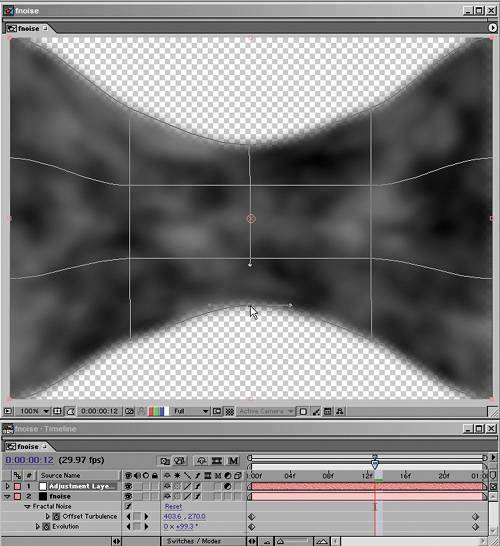 Smoke TrailsMany effects, including smoke trails, don't require particle generation in order to be re-created faithfully. Check out the reference in Figure 13.17 and you'll notice that smoke trails are just like elongated clouds, revealed over time along a linear path. Figure 13.17. You could easily paint in this effect with no source whatsoever.
Therefore, initial setup of this effect is simply a matter of starting with a clean plate, painting the smoke trails in a separate still layer, and revealing them over time (presumably behind the aircraft that is creating them). The quickest and easiest way to reveal such an element over time is often by animating a mask, but if you want to do it the cool and automatic way, you could use techniques described in Chapter 8 to apply a motion tracker to a clone brush. The optional second stage of this effect would be the dissipation of the trail; depending on how much wind there was that day, the trail would probably drift, spread, and thin out over time. That means that in a wide shot, the back of the trail would be more dissipated than the front. A simple method to achieve this (which could work with a distant shot, at least) involves using a black-to-white gradient and Compound Blur. You can use the Ramp effect to create a gradient that is white at the dissipated end of the trail and black at the source (Figures 13.18a and b). Again, you can apply a motion track to the black gradient point using expressions, or you can just approximate it by hand. To animate the amount of blur applied, animate a Levels adjustment to the gradient, keeping in mind that you may need to pre-compose the result. I offer this not so much because I think your phone will ring tomorrow morning with a client wanting dissipating smoke trails, but as an example of how to combine some of what you've learned into your own effect. Figure 13.18a and b. Getting creative with a quick-and-dirty effect on Figure 13.17: A gradient is created to match the start and end of the plane's trajectory, masked and pre-composed (13.18a). This is then applied via a Compound Blur to the source layer (13.18b)a simple example of building up your own effect with the tools at hand.
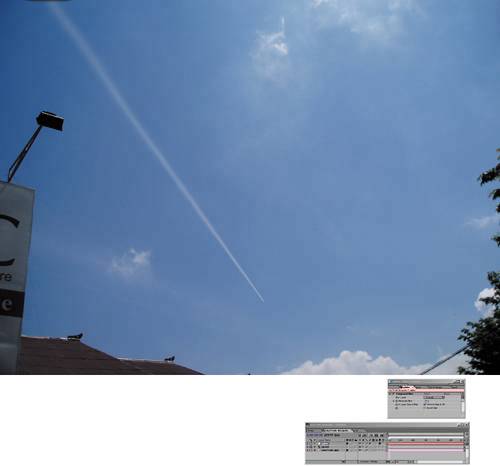 |
EAN: 2147483647
Pages: 156

